Day 1 Anywhere → or → Shanghai Pudong International Airport → Addis Ababa (First leg reference flight: PVG-ADD ET685 2330 0650+1;)
All day
Today is the gathering day for the activity. Tourists from all over the country will gather at the terminal of Shanghai Pudong International Airport around 8:00 pm (specific details will be determined in the tour book), check in under the guidance of the tour leader, and after completing the departure procedures at the designated time, take Ethiopian Airlines to Addis Ababa, the capital of Ethiopia.
Addis Ababa, located in the central Ethiopian Plateau, covers an area of 540 square kilometers and stands at an altitude of 2,500 meters, making it the highest city in Africa. As the nation's political, economic, and cultural center, it is home to numerous government agencies, businesses, and universities, including Addis Ababa University. It is also the headquarters of the African Union and a prominent transportation hub connecting multiple countries.
丨Explore the world and step on the line:
What are the differences between traveling on the line and normal travel?
Traveling is different from ordinary travel. There are many unexpected factors that affect the experience, but there are also gains and losses:
1. Fully experience the folk customs of many places, and stepping on the lines requires more detailed and in-depth understanding;
2. Will visit many unknown places or tourist spots that are not on the regular route;
3. Adventurousness: If there are unexpected attractions along the way, the itinerary may be changed at any time:
4. It may involve interviewing special people, visiting, or attending special events.
5. You will get a video of the line-stepping record edited by us.
Our product manager will communicate with you one-on-one. For more details, please click [Notice] → [Safety Tips]


Day 2 Addis Ababa → Gold Card (Reference flight number for the second leg: ADD-BCO ET271 1220 1335)
·morning
Itinerary presentation ※ First acquaintance with Ethiopia丨Jinka Town + Ari Tribe
After arriving in the capital, take a domestic flight to Jinka. Located in southern Ethiopia, Jinka is a must-see for entering Mago National Park and a gathering place for primitive tribes in the Omo Valley. It is a tourist destination where you can experience the original African customs.
·afternoon
We'll then visit the Ari Tribe, a tribe in the Omo Valley of southern Ethiopia known for their unique body decorations and traditional lifestyle. Afterwards, we'll visit the Jinka Museum. After dinner, we'll check into our hotel and rest.


Day 3 Gold Card → Lip Plate Tribe → Hammer Tribe → Turmi
·morning
Itinerary Presentation ※ Tribal Exploration丨Lip Plate Tribe + Hamar Tribe
This morning, we'll visit the Mursi tribe to photograph their lip plates. The lip plate tribe generally refers to the Mursi people, primarily found in the Omo River Valley. Women in this tribe begin piercing their lower lips in their teens, using clay or wooden plates to enlarge their lips. Larger plates symbolize higher status and beauty, and are associated with larger dowries when they marry. Afterwards, we'll return to Jinka for lunch.
Special note: Before September, visit the Key Afar village where the lip plate people moved out. After September, if they have moved back to Mago National Park, visit Mago Park.
·afternoon
In the afternoon, we will head towards Turmi, where we will visit and photograph the Hammer Tribe. The Hammer Tribe of Ethiopia is a primitive tribe in the Omo Valley, known for its unique coming-of-age ceremonies and body decorations.
·night
After dinner, check in to the local hotel to rest. Turmi is a market town in the South Omo region of the Southern Nations, Nationalities and Peoples State in southwestern Ethiopia.


Day 4 Turmi → Dassenech Tribe → Karo Tribe → Turmi
·morning
Itinerary Presentation ※ Tribal Exploration丨Dasanaqi + Kano Red Mud Tribe
In the morning, we will go to Omorate to visit and photograph the Dassenech tribe. Here we will take a local boat to cross the Omo River into the village of Dassenech and visit the relatively wealthy tribe. The bottle caps on their heads are their most special decoration.
·afternoon
In the afternoon, we'll travel to the Karo Tribe, a small tribe with a population of just over 3,000, making it the smallest of the Omo Valley's indigenous tribes. Like many other tribes, the local women bear scars on their chests and smear their hair with red mud. We'll then return to Turmi and check into a local hotel for dinner and rest.


Day 5 Turmi → Konso Tribe → Albaminchi
All day
Itinerary Presentation ※ Tribal Exploration丨Konso Primitive King Tribe
After breakfast, return to Albaminch.
We stopped by the Konso tribe to photograph them. They are the only tribe in Ethiopia with a king, and their faith is centered on the worship of waga (wooden carvings commemorating the dead). The Konso huts have thatched roofs and cow dung walls. When a house becomes unusable, they simply rebuild it in the same place. Everything we see today remains exactly as it did 3,000 years ago. The Konso people are renowned for their skill in terraced fields, which possess a unique charm distinct from those found in China's Longsheng and Yuanyang rice terraces. UNESCO has designated the Konso Cultural Landscape a World Heritage Site.
Stay in Albaminchi that night.


Day 6 Albaminchi Full Day
All day
Itinerary Presentation ※ Tribal Exploration | Dorzi Alpine Tribe + Animal Photography at Chamo Lake
Today is also a relatively restful day. After breakfast, we will go to [Chamo Lake] to cruise the lake and look for wild animals in the lake, especially crocodiles.
Afterwards, we traveled to Qingcha Village to visit and photograph the Dorze tribe, a colorful tribe living on a mountaintop. Dorze means "weaver" in the local language, and every member of this tribe is a skilled weaver. Their "elephant trunk houses" are constructed from plant leaves, rising ten meters in height, where both humans and animals live together.
Then return to the hotel to rest.


Day 7 Arbaminchi → Awasa → Sidamo Coffee Farm
·morning
Itinerary Presentation ※ Humanistic Creation丨Awasa Fish and Bird Market + Sidamo Coffee Farm
After breakfast, head towards Awasa, passing by the Awasa Fish and Bird Market and Awasa Park.
·afternoon
In the afternoon, we'll head to Sidamo Coffee Farm (30 kilometers from Hawassa, a 1.5-hour drive one way). Sidamo, also known as Sidamo, is a renowned specialty coffee-producing region in Ethiopia. Located on a plateau south of Lake Awassa in the East African Rift Valley, at an altitude of 1,400 to 2,200 meters, Sidamo boasts fertile volcanic soil, abundant rainfall, and a diverse microclimate, creating an ideal environment for coffee growth. Its coffee is renowned for its bright, fruity acidity, floral aromas, and smooth taste, with flavors ranging from citrus to lemon and tropical fruit. The diverse flavor profile varies from village to village depending on factors such as soil and altitude.
Then return to Hawassa to rest.


Day 8 Awasa → Abiyatashala National Park → Addis Ababa
All day
Itinerary presentation ※ Animal Safari丨Abbiatashala National Park
Today's drive is long and we need to drive back to the capital.
During the trip, we'll visit Abiyatashala National Park, a key nature reserve in Ethiopia for its rich ecosystem and diverse wildlife. Mammals include lions, elephants, zebras, giraffes, wild boars, and gazelles, while birds include ostriches and flamingos. The park also boasts a hot spring, a unique attraction for visitors.
Stay in Ethiopia's capital that night.
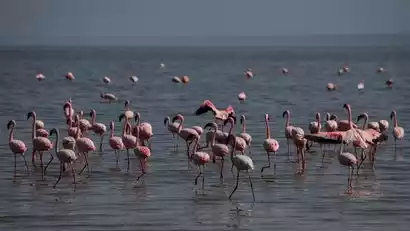
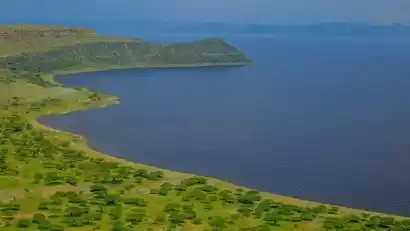
Day 9 Addis Ababa → Semera → Avdera → Erta Ale (Reference flight: ET110 06:40 - 08:30)
·morning
Itinerary presentation ※ Volcano Camping | Erta Ale Volcano Hiking + Crater Camping
After breakfast, we will fly to Semera, the capital of the Afar region.
The expedition team will pick us up at the airport and take us by 4x4 vehicle directly to the Danakil Depression, following a flat road to the hot and dusty city of Avdara, where we will have lunch.
·afternoon
Soon after leaving Avdara, the road turned into a bumpy gravel track until we reached the base of Erta Ale volcano.
After a short rest, we began a short climb, about 30 minutes' walk, to the rim of the crater. Erta Ale, at 613 meters above sea level, is considered one of Ethiopia's most captivating natural attractions. It's a shield volcano with a 30-kilometer diameter at its base and a 1-square-kilometer crater at its summit, containing one of the world's few permanent lava lakes.
·night
Spending the night in an open-air camp on the rim of the crater, gazing at the shimmering lava, is truly an unforgettable experience!
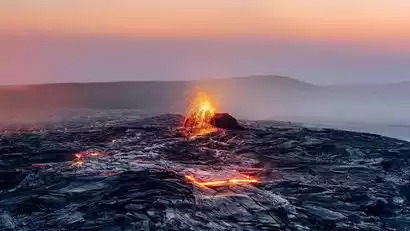
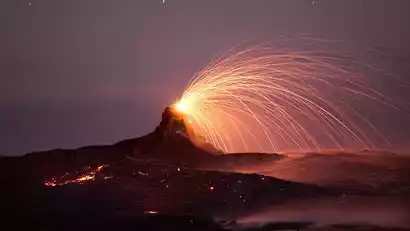
Day 10 Erta Ale → Hamad Ella → Lake Assal
·morning
Itinerary presentation ※ Salt Lake Creation丨Off-road vehicle crossing the lava desert + Assal Salt Lake sunset
After breakfast at the camp, we'll continue our journey by off-road vehicle, following a bumpy road through the lava desert. It takes approximately four hours to reach our campsite, Hamad Ela. Hamad Ela is a collection of simple huts at the end of the world, and the weather here is extremely hot year-round! The cooler months are typically from October to March, making it a more accessible time for tourists.
·afternoon
In the evening, we depart for Lake Assal. Here, we'll not only witness traditional salt mining but also encounter camel caravans transporting salt blocks to the Ethiopian plateau. We'll also photograph the sunset over the salt lake.
·night
We will camp at Hamad Ela Camp at night.
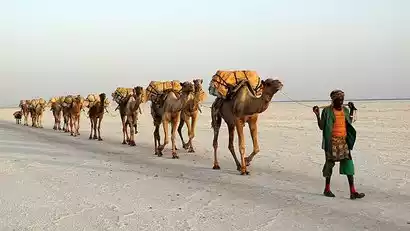
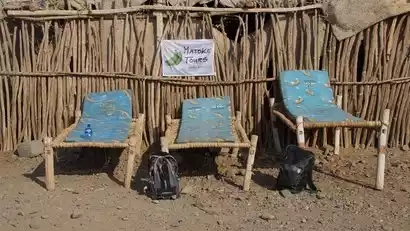
Day 11 Hamad Ella → Dallol Volcano → Mekre → Addis Ababa (Reference flight: MQX-ADD ET299 19:45 21:15)
All day
Itinerary Presentation ※ In-depth exploration | Dallol Depression + Dallol Volcano scenery
Today we'll set out early to explore the breathtaking landscapes surrounding Dallol. The Dallol Depression, at 116 meters below sea level, is one of the lowest and hottest places on Earth. The Dallol Volcano, though covered in thick layers of salt, still reveals its remarkable salt formations, hundreds of fumaroles (gas vents), and a vibrant acidic lake. We'll then explore other highlights of the area.
Then drive from Dallol to Mekelle and take a domestic flight back to the capital, Addis Ababa. After dinner, check into the capital hotel to rest.
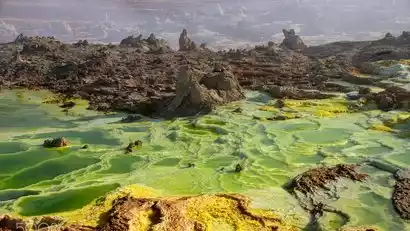
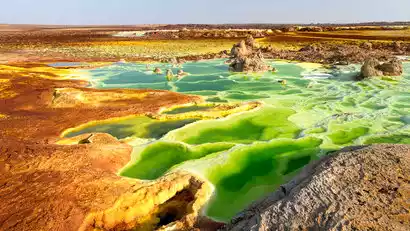
Day 12 Addis Ababa City Tour
All day
Itinerary Presentation ※ City Exploration丨Addis Ababa City Tour
After breakfast, we'll embark on a city tour of Addis Ababa, starting with a visit to Entoto Mountain, home to the Menelik II-era palace, St. Mary's Church, and the Ethiopian Space Science Institute's observatory. We'll then proceed to the National Museum (Lucy's home), followed by visits to the Ethnology Museum, the Natural History Museum, and the Holy Trinity Cathedral, where we'll experience the Ethiopian coffee ceremony. Dinner will include a local injera meal accompanied by music and dance. After dinner, we'll board our flight home that evening.
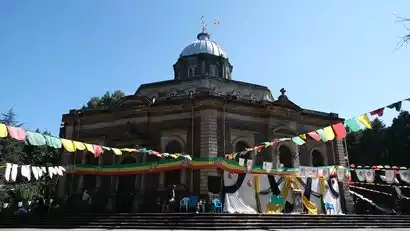

Day 13 Addis Ababa → Shanghai Pudong International Airport (Reference flight: ADD-PVG ET684 0040 1725)
All day
We'll arrive at Shanghai Pudong International Airport at 3:45 PM, concluding our delightful exploration of Ethiopia's culture and volcanic landscapes. Remember to submit your work on the China-TravelNote forum and share your wonderful experiences!








